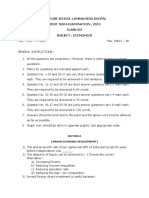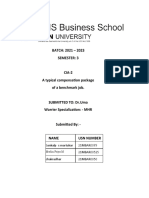0 ratings0% found this document useful (0 votes)
41 viewsAnushruti@srcc - Du.ac - In: Commented (U1) : Without The Existence of A Surplus in
The document provides instructions for an assignment on development economics requiring students to answer any 10 questions out of 29 provided. The questions cover topics such as dual economy models, rural-urban migration, determinants of fertility, population growth, and economic development.
Uploaded by
akash rajCopyright
© © All Rights Reserved
Available Formats
Download as PDF, TXT or read online on Scribd
0 ratings0% found this document useful (0 votes)
41 viewsAnushruti@srcc - Du.ac - In: Commented (U1) : Without The Existence of A Surplus in
The document provides instructions for an assignment on development economics requiring students to answer any 10 questions out of 29 provided. The questions cover topics such as dual economy models, rural-urban migration, determinants of fertility, population growth, and economic development.
Uploaded by
akash rajCopyright
© © All Rights Reserved
Available Formats
Download as PDF, TXT or read online on Scribd
You are on page 1/ 2
Development Economics II: Assignment on Unit 1 (For Semester 6 Section C)
Instructions: Attempt any 10 questions in groups of two students each and submit via email by Friday, 27th March, 2020. Email
id for submission: anushruti@srcc.du.ac.in. Answers can be typed or scanned copies of handwritten answers.
1. Evaluate the validity of the following statements:
a. In the HT model, an increase in formal sector L demand at fixed wage rates must lower the proportion of workers
employed in the informal sector as a fraction of the total urban labour force
b. If governments are unable to tax agriculture then, the labour supply curve to industry in Lewis model is always
upward sloping.
c. In the dual economy model, the phase of disguised unemployment must be associated with a horizontal supply
curve of industrial labour.
d. Migration restrictions alone lead to too many people in the informal sector.
2. Priya and her 3 sisters own a farm in rural TN. The value of the output they produce is Rs. 4000 which they divide equally
among themselves. The urban sector offers informal jobs paying Rs. 500 and formal jobs paying Rs. 1200. The probability
of getting these jobs depends on the proportion of such jobs to the urban labour force.
a. Assuming that Priya compares her expected returns in the two sectors and migration is costless, calculate the
threshold proportion of formal jobs to urban labour force that will just deter Priya from migrating.
b. The production function of Priya’s farm is:
N(workers) Y(Rs)
1 sister 1,500
2 sisters 2,500
3 sisters 3,300
4 sisters 4000
Assuming that Priya and her sisters seek to maximise their total family income and the threshold proportion
derived in (a) prevails in the urban sector, prove that Priya will migrate. Will any of priya’s sisters also wish to
migrate?
c. Briefly explain the economic reasons to contrast Priya’s decision in (a) and (b).
3. Why is an understanding of social norms important in explaining economic behaviour? Briefly explain the significance of
these norms in determining (i) fertility choices (ii) the quality of common property resources.
4. Show how the size of the urban informal sector is endogenously determined in the HT model. What is meant by the
Todaro paradox?
5. What is meant by ‘survival probability’? What are its components and how do they influence individual fertility decisions?
6. Consider the population growth of an economy.
a. Why does a young age distribution make it more difficult for a country to slow its rate of population growth?
b. How do you expect changes in female wages to effect fertility and why?
c. If a country suddenly drops its total fertility rate to two, describe the path the population takes:
i. In the short run
ii. In the long run
7. Explain the progressive transformation of ‘traditional’ sectors into ‘modern’ sectors based on the fundamental resource
flows. What makes this model work?
8. What are the major determinants of fertility? Why will the population continue to grow even if fertility rates in developing
countries fall rapidly?
9. Discuss the “Cost-benefit Approach” to fertility choice.
10. Explain how economic development affects population growth.
11. Distinguish between the following concepts:
i. Micro and macro inertia
ii. Hoarding and targeting
iii. Private costs and social costs in fertility decisions
iv. Fertility choice and missing markets.
12. Using a model of structural transformation, explain how while capital accumulation in the industrial sector is the engine
of growth, the ability to expand the industrial sector is crucially determined by the production conditions in agriculture. Commented [u1]: Without the existence of a surplus in
13. (a) Show how community’s coordination on social norms can lead to high total fertility rates. agriculture, it is difficult to create growth in industries
14. (b) ‘The appreciating value of women’s time reltive to men’s plays an important role in fertility transition’ Elaborate.
15. Are the following statements true, false or uncertain? Give brief explanations for your answer.
a) A well implemented ban on child labour may lower fertility rates.
b) If country X has a lower rate of growth of population than country Y, then the average woman in X has fewer
children than her counterpart in Y.
c) If total mortality among children remained constant, but the incidence of that mortality shifted from late
childhood to early childhood, fertility rates should decline.
16. (a) Explain the HT equilibrium with reference to the urban wage rates in formal and informal sectors.
(b) Briefly explain the paradox of urban job creation in the context of the HT model.
(c) What are the policies advocated to move the economy towards an efficient labour allocation?
17. Explain the Lewis model of economic growth. Critically examine its implications on the process of economic growth in a
developing economy.
18. Discuss the role of agricultural surplus in economic development. Examine the efficacy of an agricultural tax to mobilise
this surplus for investment in industry.
19. In the 1950s, facing massive unemployment in cities (much of it disguised in the informal sector) the Kenyan Government
embarked on a Keynesian policy of creating new jobs through public investment. By many accounts, the size of the
informal sector went up in the months that followed. How would you explain this phenomenon? Elaborate.
20. “Capital accumulation in the industrial sector is the engine of economic development that proceeds via the joint transfer
of labour and agricultural surplus from the traditional agricultural sectors to the modern industrial sector” Explain this
statement wrt to the Lewis-Ranis-fei model of migration.
21. (a) What are hoarding and targeting in demographic choice? How does it influence the demographic status of the society?
(b) Consider a traditional society where only women look after the children. How will the fertility decision change if there
is an increase in the male wage? Show the effect with the help of necessary diagrams.
22. What are the social and economic factors on which fertility decisions at the household level depend? Explain the impact
of population growth on economic development.
23. Explain the process of economic development with unlimited supplies of labour. Are there any limitations on this process?
What policy measures can be adopted in the course of development?
24. Discuss the theory of demographic transition. Define the role of micro and macro inertia in population growth. In this
regard, also explain the role of:
(a) Institution of social security
(b) Survival probability.
25. (a) Explain how negative externalities can contribute to micro-inertia in household fertility behaviour.
(b) What is the impact of a rise in wage and non-wage income on household fertility behaviour?
(c) What are the negative effects of high population growth on the economic prospects of developing countries?
26. “Despite limitations, the Lewis model retains high analytic value for its insights into the development process of the
developing countries” Discuss and elaborate.
27. In what ways according to Malthus and Solow, population growth effects economic development?
28. Discuss the role of gender-bias in determining (i) fertility choice under the assumption of zero costs (ii) opportunity cost
of having children.
29. In what way does the HT model of rural-urban migration act as a constraint on the dual economy model proposed by A.
Lewis?
You might also like
- The Study of Global Political Economy John Ravenhill Chapter 1No ratings yetThe Study of Global Political Economy John Ravenhill Chapter 127 pages
- Tony Robbins Business Mastery 2016 London Brochure75% (4)Tony Robbins Business Mastery 2016 London Brochure4 pages
- Mark Minervini Setup Mark Minervini SetupNo ratings yetMark Minervini Setup Mark Minervini Setup3 pages
- Marketing, Introduction Chapter 1 Rosalind Masterson & David Pickton80% (10)Marketing, Introduction Chapter 1 Rosalind Masterson & David Pickton36 pages
- CHAPTER-7-INDIAN ECONOMY-EMPLOYMENT-GROWTH, INFORMALISATION AND OTHER ISSUESNo ratings yetCHAPTER-7-INDIAN ECONOMY-EMPLOYMENT-GROWTH, INFORMALISATION AND OTHER ISSUES9 pages
- CBSE 15 Sample Question Papers Class 10 EnglishNo ratings yetCBSE 15 Sample Question Papers Class 10 English15 pages
- Notes On Sectors of Indian Economy Updated (12.8.19)No ratings yetNotes On Sectors of Indian Economy Updated (12.8.19)10 pages
- Rural and Urban Dynamics and Poverty: Evidence From China and IndiaNo ratings yetRural and Urban Dynamics and Poverty: Evidence From China and India50 pages
- Sample Question Paper Economics (030) Class XII (2014-15)No ratings yetSample Question Paper Economics (030) Class XII (2014-15)21 pages
- ch-3 Changes and development in rural societyNo ratings yetch-3 Changes and development in rural society3 pages
- Society Soc Justice Revision Answer Writing Classes Lecture 45 07No ratings yetSociety Soc Justice Revision Answer Writing Classes Lecture 45 0740 pages
- IBPS PO Prelims Memory Based Paper (Held On_ 23 September 2023 Shift 2)No ratings yetIBPS PO Prelims Memory Based Paper (Held On_ 23 September 2023 Shift 2)31 pages
- Red Rose School Lambakheda Bhopal First Term Examination, 2019 Class Xii Subject: EconomicsNo ratings yetRed Rose School Lambakheda Bhopal First Term Examination, 2019 Class Xii Subject: Economics5 pages
- All Questions Are Compulsory:: Class TestNo ratings yetAll Questions Are Compulsory:: Class Test2 pages
- Lewis Model and China: Theory and ApplicationsNo ratings yetLewis Model and China: Theory and Applications21 pages
- ncert_solutions_for_class_12_economics_chapter_-_employment_growth_informalisation__related_issues (1)No ratings yetncert_solutions_for_class_12_economics_chapter_-_employment_growth_informalisation__related_issues (1)5 pages
- Governing Green Industrialisation in AfricaNo ratings yetGoverning Green Industrialisation in Africa14 pages
- Class 12 Sociology PYQs with Solution Ch 2 The Demographic Structure of the Indian Society100% (1)Class 12 Sociology PYQs with Solution Ch 2 The Demographic Structure of the Indian Society15 pages
- Online Strategies For Retail Store During Pandemic 1No ratings yetOnline Strategies For Retail Store During Pandemic 133 pages
- A Project Report On Comparative Study of Insurance Plans of Various CompaniesNo ratings yetA Project Report On Comparative Study of Insurance Plans of Various Companies117 pages
- Denada Lica - The Strategy of International BusinessNo ratings yetDenada Lica - The Strategy of International Business2 pages
- PRINT Traditional Managerial Vs Entrepreneurial Management100% (2)PRINT Traditional Managerial Vs Entrepreneurial Management4 pages
- Handmaid of Ethics: Corporate Social ResponsibilityNo ratings yetHandmaid of Ethics: Corporate Social Responsibility16 pages
- Scientific Management Theory and Administrative Theory by Junime GumelaNo ratings yetScientific Management Theory and Administrative Theory by Junime Gumela27 pages
- Activity 6 - Theory of Production and CostNo ratings yetActivity 6 - Theory of Production and Cost5 pages

























































































